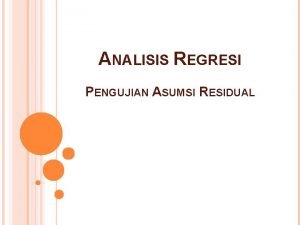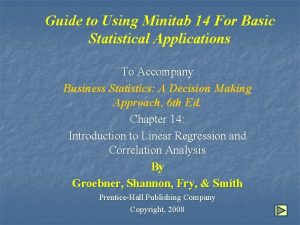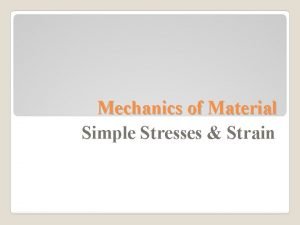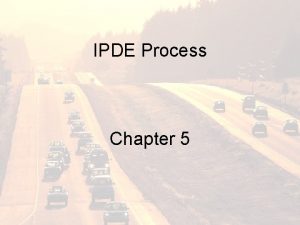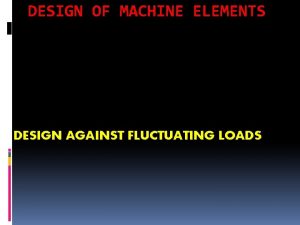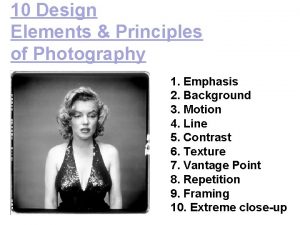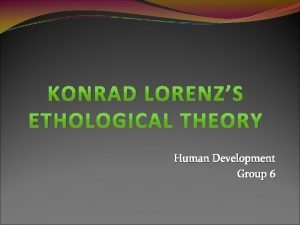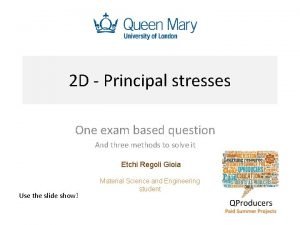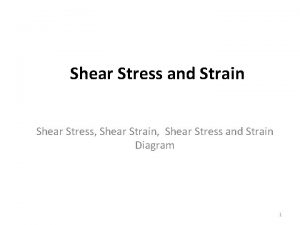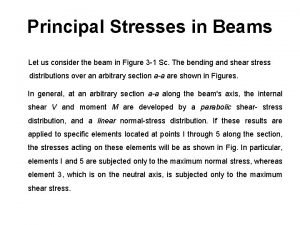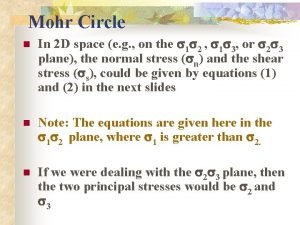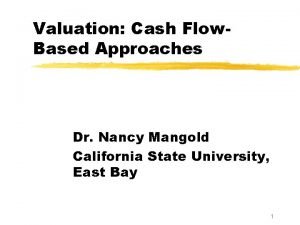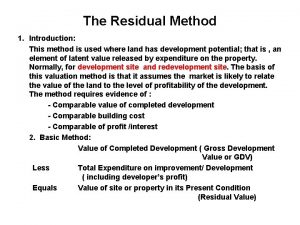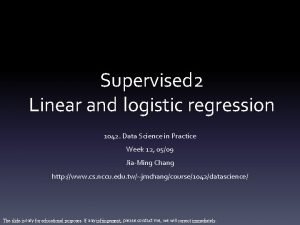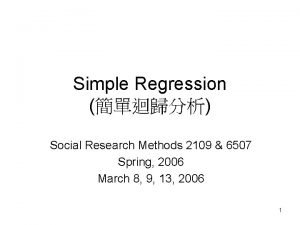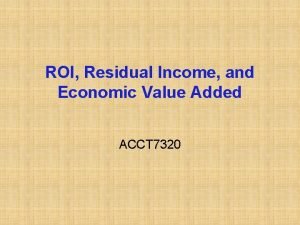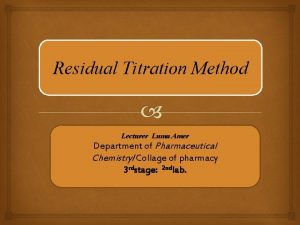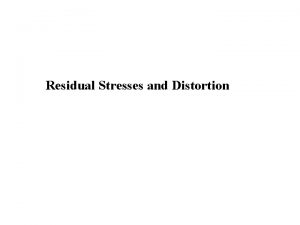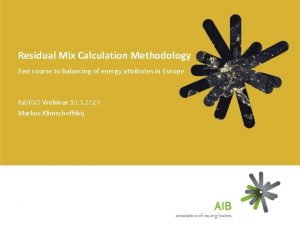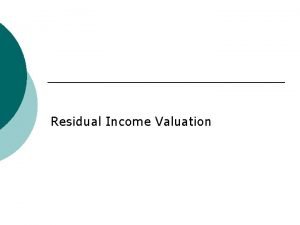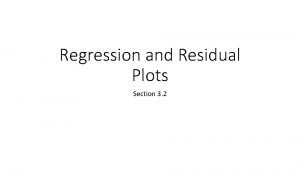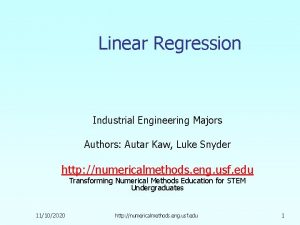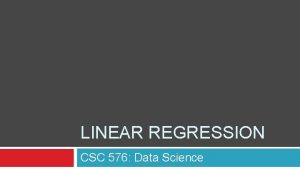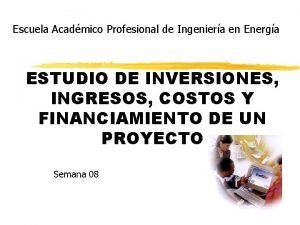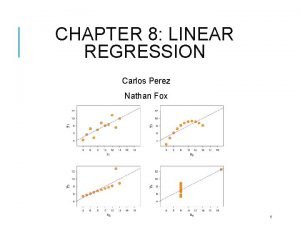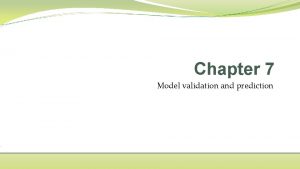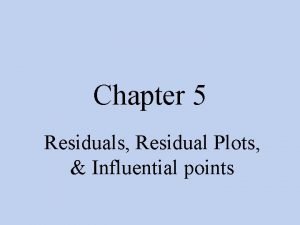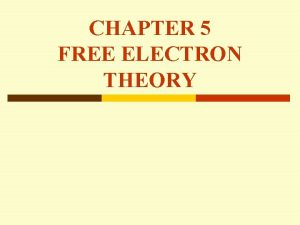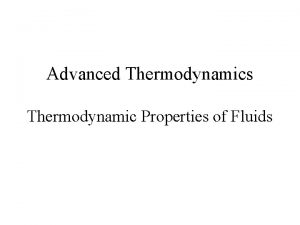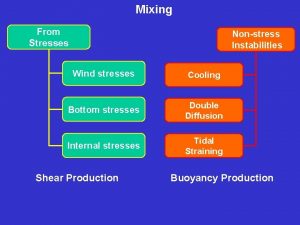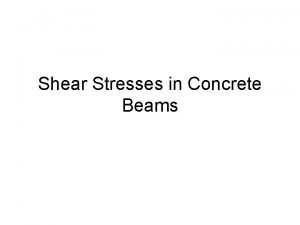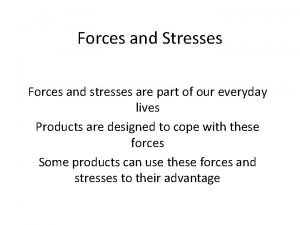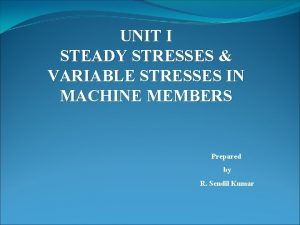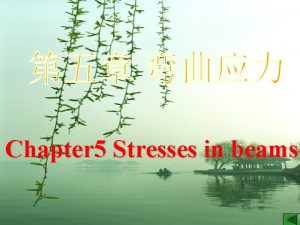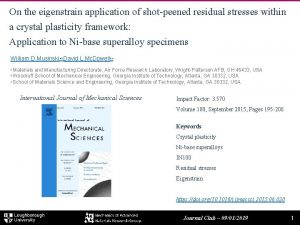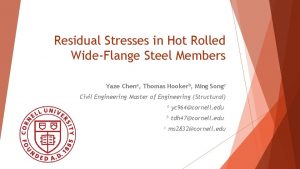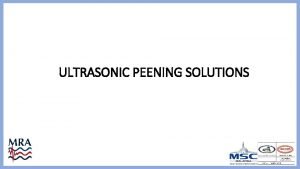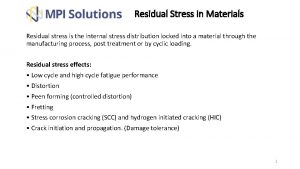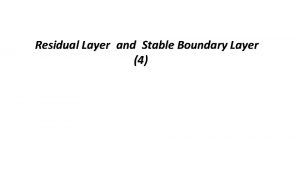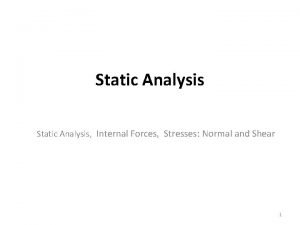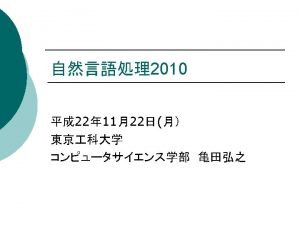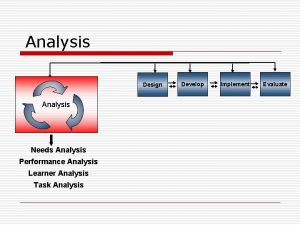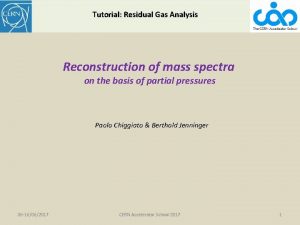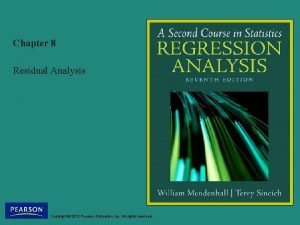residual stresses residual stresses analysis of residual stresses






















![residual stresses Kornwechselwirkungmodelle – Beispiele Kröner 1/2 S 2 [mm 2/N] -S 1 [mm residual stresses Kornwechselwirkungmodelle – Beispiele Kröner 1/2 S 2 [mm 2/N] -S 1 [mm](https://slidetodoc.com/presentation_image_h2/474590d5add85fa1882ef99b604b7256/image-23.jpg)





















- Slides: 44

residual stresses

residual stresses analysis of residual stresses in crystalline materials by use of X-rays - determination of the stress/strain tensor - possibilities to investigate strain gradients - line positions are converted into strains and those into stresses (stress measurements yield a couple of extra information) - used for bulk and layered materials

residual stresses a body is under stress when its atoms are shifted away from their eqilibrium positions DEF: a force, which increases/decreases atomic distances os positive/negative F F theoretical strength Fth a 0 r + - a 0 r ~ linear (= elastic behaviour) 3

residual stresses analysis of residual stresses in crystalline materials by means of X-ray diffraction - kinds of residual stress The 3 kinds of residual stress are additive!

residual stresses origins of residual stresses - lattice misfit at boundaries different coefficients of thermal expansion of phases material processing (e. g. surface modifications) welding coatings deformation (in situ) 5

residual stresses stress and strain are tensorial properties http: //www. maschinenbau-wissen. de/skript 3/mechanik/festigkeitslehre/116 -spannungstensor 6

residual stresses concept of residual stress analysis by XRD - let a sample be under stress, parallel to its surface - change of interplanar distances in a crystallite depending on its orientation relative to the (field of) stress in the sample coordinate system - residual stress analysis by XRD determines elastic deformation of the lattice as a function of the direction Welzel et al. , J. Appl. Cryst. 38 (2005) 1 7

residual stresses concept of residual stress analysis by XRD - change of interplanar distance is a function of the external (field of) stress - it varies also as a function of the mutual orientation of lattice plane normal and stress - measurement of this directional dependence Welzel et al. , J. Appl. Cryst. 38 (2005) 1 8

residual stresses concept of residual stress analysis by XRD - change of interplanar distance is a function of the external (field of) stress - it varies also as a function of the mutual orientation of lattice plane normal and stress - measurement of this directional dependence Welzel et al. , J. Appl. Cryst. 38 (2005) 1 9

residual stresses concept of residual stress analysis by XRD - measurement of the position of a single diffraction line - definition of residual stresses of 1 st kind - interplanar spacings are measured only along the diffraction vector (lattice planes are normal to them) - only a certain fraction of crystallites diffracts - -> residual stresses determined by mechanical methods likely to differ from XRD values Welzel et al. , J. Appl. Cryst. 38 (2005) 1 10

residual stresses concept of residual stress analysis by XRD j…rotation around the surface normal of the sample y…angle between surface normal and diffraction vector measured: all diffracting crystallites along L 3 ODF rotation around diffraction vector angeles j and y describe the direction of the diffraction vector relative to the strain field Welzel et al. , J. Appl. Cryst. 38 (2005) 1 11

residual stresses basic equations – isotropic crystallites - assumption: polycrystal, assembled from elastically isotropic crystallites - elastic properties of the polycystal = elastic properties of an isotropic crystallite elongation of crystallites along the diffraction vector rotation of sample coordinate system into the laboratory coordinate system - relation between strain and stress for polycrystals composed of elastically isotropic crystallites 12

residual stresses basic equations – isotropic crystallites the sin 2 y method - holds for strain from diffraction measurements as well as for mechanical measurements - for homogeneous stress fields and elastically isotropic crystals also valid upon presence of textures 13

residual stresses basic equations – anisotropic crystallites - realistic case: polycrystals are composed of elastically anisotropic crystallites - stress and strain vary from crystallite to crystallite, given the mutually different orientations of crystallites and stress field - resultant stress/strain is described by grain interaction models -> quasi-isotropic samples: sample appears elastically isotropic although each crystallite is elastically anisotropic - no texture !!!! - grain interaction is direction-dependent - for quasi-isotropic samples: use of X-ray elastic consants (XEC = S 1, ½S 2) - for makroscopically anisotropic samples (e. g. textured), the X-ray stress factors (XSF) have to be used 14

residual stresses basic equations – anisotropic crystallites the sin 2 y equation, differs from the isotropic case only in form of the XEC - XEC‘s depend only on the diffracting lattice plane family and the chosen grain interaction model - obtained stress and strain differ from the mechanical values - sin 2 y method is applicable for all stress states in quasi-isotropic polycrystals 15

residual stresses grain interaction models - calculation of XEC or XSF - can be measured (strain measurement with known external applied stress) - usually calculated from the 2 nd order elastic constants of single crystals - Hooke‘s law Einstein summation - 6 independent equations - 12 independen components - solving a linear system of equations, where 6 of the independent components are known - assumption: 6 of the components are equivalent to the mechanical values averaged for all crystallites 16

residual stresses grain interaction models – Voigt model - assumption: homogeneous strain - causes stress jumps at grain boundaries, which violate the mechanical eqilibrium - incompatible with realistic cases - individual (lengthy) expressions for all crystal systems possible - e. g. cubic systems: - Voigt XECs have no hkl dependence 17

residual stresses grain interaction models – Reuss model - assumption: homogeneous stress - strain inhomogeneities at grain boundaries (crystal would break up) - incompatible with realistic cases - individual (lengthy) expressions for all crystal systems possible - e. g. cubic: - Reuss XECs depend on hkl 18

residual stresses grain interaction models – Eshelby-Kröner model - assumption: an anisotropic crystallite is embedded in an isotropic matrix with the properties of the full polycrystal - expresses the mismatch of the elastic properties between particle and matrix (!!!: averaging of the deviations for all crystallites = 0 interative solution) - calculate stress/strain for an embedded spherical particle - analytical solution only for isotropic cases - extendable to textured samples (no analytical solution) - currently the most realistic model, but hard to calculate 19

residual stresses grain interaction models – Vook-Witt model - special model for thin films assumption: crystallite is in 3 dimensions sourrounded by other crystals 2 extremal cases for the grain interaction models (Voigt, Reuss) layers are low dimensional structures - Vook-Witt model: makroskopische transverse Isotropie (in der Schichtebene) - strain is rotational symmetric in layer plane - strain is equal for all crystallites (V) - stresses normal to the layer plane vanish (R) - inverse Vook-Witt model: - stress is rotational symmetric in layer plane - stress is equal for all crystallites (R) - strain normal to the layer plane is equal for all crystallites (V) 20

residual stresses grain interaction models – Neerfeld-Hill model (effective grain interaction) - XECs of limiting grain interaction models do not corespond to reality - averagingn the extreme cases: parts of the crystals follow one extreme case, the other part the other extreme case - Neerfeld-Hill: averaging of Voigt and Reuss models for compact polycrystals - empitical: arithmetic or geometric average from V and R - weighting: ½ - weighting can also be refinement parameter 21

residual stresses U grain interaction models – examples Sn 22
![residual stresses Kornwechselwirkungmodelle Beispiele Kröner 12 S 2 mm 2N S 1 mm residual stresses Kornwechselwirkungmodelle – Beispiele Kröner 1/2 S 2 [mm 2/N] -S 1 [mm](https://slidetodoc.com/presentation_image_h2/474590d5add85fa1882ef99b604b7256/image-23.jpg)
residual stresses Kornwechselwirkungmodelle – Beispiele Kröner 1/2 S 2 [mm 2/N] -S 1 [mm 2/N] 23

residual stresses measurement strategies - angle y sets direction of measurement relative to the sample surface (normal) - y, j represent the relative orientation of {hkl} lattice plane normals in the sample coordinate system (sin 2 y equation) - f, w, c (instrument angles) stand for the sample orientation in the laboratory coordinate system - 2 q is used to select the requested {hkl} lattice plane

residual stresses measurement strategies w mode (c = 0) - variation of w (q = qhkl) causes variation in y according to y = w-q angle of incidence = w, exit angle = q-y limited range of y (beam parallel to surface |y|<q)

residual stresses measurement strategies w mode (c = 0) - variation of w (q = qhkl) causes variation in y according to y = w-q angle of incidence = w, exit angle = q-y limited range of y (beam parallel to surface |y|<q) c mode (w = q) - c = y (‚y mode‘) variation of c causes variation of y angle of incidence, exit angle sin w·cos c j rotated by 90° with respect to w mode y limit (theoretically) at 90°

residual stresses measurement strategies w mode (c = 0) - variation of w (q = qhkl) causes variation in y according to y = w-q angle of incidence = w, exit angle = q-y limited range of y (beam parallel to surface |y|<q) c mode (w = q) - c = y (‚y mode‘) variation of c causes variation of y angle of incidence, exit angle sin w·cos c j rotated by 90° with respect to w mode y limit (theoretically) at 90°

residual stresses measurement strategies - defocussing caused by inclination of the sample parallel beam geometries recommended

residual stresses measurement strategies - defocussing caused by inclination of the sample parallel beam geometries recommended

residual stresses measurement strategies glancing angle method - measurement of residual stress in thin films/surface layers - method has constant depth of penetration (stress-depth-profiling) - angle of incidence fixed (penetration depth!) limited freedom to vary y - multiple c: angle of incidence w small, variation of c causes variation in y (combination of w- and c-mode) - Multiple {hkl}: angle of incidence w small, c = 0, variation in 2 q causes variation in y according to y = qhkl-w (y, qhkl nicht unabhängig voneinander) - multiple l: change of wavelength changes qhkl and accordingly y, angle of incidence needs to be corrected for the wavelength

residual stresses measurements - categories

residual stresses data treatment: macroscopic elastically isotropic samples - determination of the lattice strain along a certain direction measurement (y, j) with respect to the components of the strain tensor in the sample coordinate system - theoretically: 6 independent components of the stress tensor -> strains have to be measured along 6 independent directions (solving a linear system of equations) - traditional: reshaping of the sin 2 y law in order to obtain the components of the strain/stress tensor, from linear regressions of functions in j, y, hkl - single {hkl} or multiple {hkl} - least squares methods

residual stresses data treatment: macroscopic elastically isotropic samples single {hkl}: sin 2 y-sin(2 y) + triaxial stress state

residual stresses data treatment: macroscopic elastically isotropic samples single {hkl}: sin 2 y-sin(2 y) + triaxial stress state - for general stress states, the functions in sin 2 y / sin(2 y) are non-linear - linearisation: vs. sin 2 y vs. sin(2 y) j = (0°, 45°, 90°)

residual stresses data treatment: macroscopic elastically isotropic samples single {hkl}: sin 2 y-sin(2 y) + tiaxial stress state - for general stress states, the functions in sin 2 y / sin(2 y) are non-linear - from 3 j-angles (0°, 45°, 90°) 3 slopes (Ai) for a+j are obtained - from 2 j-angles (0°, 90°) 2 slopes (Ai) for a-j are obtained - additional condition for the 4 th stress component in a+j from ej 0 hkl

residual stresses no j-dependence mainly used in combination with glancing angle diffraction methods, measurement of multiple {hkl}

residual stresses biaxial stress state http: //paulino. ce. gatech. edu/courses/cee 570/2013_prior/FAQs/Plane_stress. png 37

residual stresses glancing angle diffraction (GAXRD) for thin films S S 0 Diffracting crystallites 38

residual stresses glancing angle diffraction (GAXRD) for thin films S S 0 Diffracting crystallites 39

residual stresses sin 2 y method PLANE STRESS in principle reference frame: Welzel et al. , J. Appl. Cryst. 38 (2005) 1 40

residual stresses sin 2 y method (data analysis) for rotational symmetric stres state - no texture - homogeneous sample - isotropic elastic properties - … djy d 0 sin 2 y Welzel et al. , J. Appl. Cryst. 38 (2005) 1 41

residual stresses biaxial, rotational symmetric stress state

residual stresses

residual stresses choice of {hkl}
 Sisaan
Sisaan Residual plot minitab
Residual plot minitab The sociological perspective stresses that
The sociological perspective stresses that Mechanics of material
Mechanics of material What factors can cause the ipde process to take more time
What factors can cause the ipde process to take more time Fluctuating loads
Fluctuating loads Forces dt
Forces dt Stresses movement makes the viewer feel alive in the moment
Stresses movement makes the viewer feel alive in the moment Konrad lorenz theory child development
Konrad lorenz theory child development Truss roof design
Truss roof design Find principal stresses
Find principal stresses Pure shear
Pure shear Principal stress formula
Principal stress formula Hydrostatic stress mohr's circle
Hydrostatic stress mohr's circle Principal stress
Principal stress Residual cash flow
Residual cash flow Land residual method
Land residual method Residual properties in thermodynamics
Residual properties in thermodynamics Logistic regression residual deviance
Logistic regression residual deviance Regression
Regression Residual income vs roi
Residual income vs roi Residual titration คือ
Residual titration คือ Distortion
Distortion Atwood's classification of residual ridges
Atwood's classification of residual ridges Residual mix
Residual mix Residual income model formula
Residual income model formula Residual income valuation
Residual income valuation Residual income valuation model example
Residual income valuation model example How to find standard deviation of residuals
How to find standard deviation of residuals Residual drawdown
Residual drawdown Residual risk and secondary risk pmp
Residual risk and secondary risk pmp Dentomucosoportada
Dentomucosoportada ¿qué es un riesgo residual?
¿qué es un riesgo residual? When x = 4, what is the residual? –3 –1 1 3
When x = 4, what is the residual? –3 –1 1 3 Residual standard error
Residual standard error Phasets
Phasets Valor residual de un activo
Valor residual de un activo Inercia
Inercia Kaiming he
Kaiming he Negative residual meaning
Negative residual meaning Residual standard deviation
Residual standard deviation Section 10 topic 5 residuals and residual plots
Section 10 topic 5 residuals and residual plots Residual resistance
Residual resistance Lessor versus lessee
Lessor versus lessee Residual properties thermodynamics
Residual properties thermodynamics
